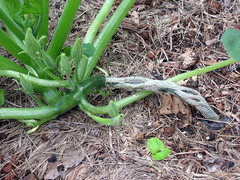Splitting Sqash Stems
Last year I sowed my squash indoors and transplanted them to the garden. This year I planned to do the same thing, but only 4 out of 16 seeds successfully germinated indoors, so I had to resow outdoors. I have already documented some of the reasons why you should sow squash directly outdoors instead of starting them indoors, but I recently discovered another reason that involves splitting stems in transplants.
This squash was sown indoors and transplanted into the garden. Notice that the main stem is long and split in many places. This makes the squash susceptible to stem rot and boring insects. This same thing happened to my squash plants last year, and although they did produce fruit, they did not produce abundantly and they died earlier in the season than I thought they should.

Compare the above results with a plant that was sowed outdoors. This is the same type of squash, but the main stem looks completely different. First, the plant is sitting more upright instead of sprawling on the ground, and second, there is no splitting in the stem.

The 12 plants that were sown outdoors are also larger and will most likely produce more fruit than their counterparts that were sown indoors. Squash seeds germinate very quickly, and the plants grow fast, so you are not losing any time by waiting to sow outdoors. I am glad I had such a low success rate with indoor sowing this year so I could learn this very valuable lesson!
Other plants I have grown that prefer direct sowing are; peas, beans, lettuce, spinach, corn and carrots.
Labels: asheville, gardening, squash, vegetables

1 Comments:
Wow! That is a HUGE difference!
Post a Comment
Subscribe to Post Comments [Atom]
<< Home